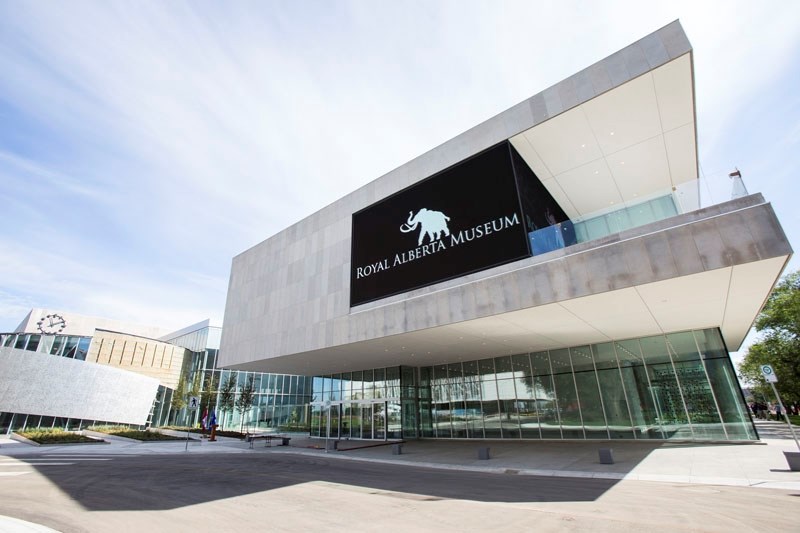The new Royal Alberta Museum sits at the intersection of Edmonton’s French and British histories.
Literally.
An aerial view (or quick search on Google maps) of the site, located on 103A Avenue opposite the city’s downtown courthouse, reveals that the intersecting streets of 99 Street and 97 Street do not lay parallel to one another.
Rather they angle towards each other – a testament to the French riverlot system used by initial settlers, which saw land parceled out in long narrow stretches along the river to maximize access. The rest of downtown is divided in neat little rectangles with streets following the cardinal directions, laid out by British surveyors during the Dominion Land Survey.
Architect Donna Clare honours this cartographic collision through the layout of the building’s interior.
The long-term galleries, which will feature Alberta’s human and natural histories, are built along the pure north-south grid, while the feature gallery, which will house travelling exhibits, is angled to the French riverlot alignment.
“This building couldn’t be anywhere else,” explained Clare, a principal at DIALOG, which won the commission to re-envision the RAM in 2011. “For me that’s when a building is really powerful, when it couldn’t be anywhere else.”
The new RAM, which celebrated an important milestone Tuesday as primary building construction wrapped up, will tell Alberta’s story not only through the 2.2 million artifacts that will be rotated through its yet-to-be-fabricated human and natural history galleries, but through the design of the building itself.
In the lobby, two lines meet near the entrance of the café by the courtyard.
The dark tiles represent 98 Street and 104 Avenue, which were lost to the 1960s obsession with creating superblocks – buildings grouped around open plazas.
“We put the lobby in the intersection, so that this becomes that community gathering space,” explained Clare. “It allowed us to draw nature in, because our museum is quite unique too in that it’s human history and natural history. We wanted to play between the two.”
The nods to nature are many, from the perforated feature exhibit wall displaying a map of Alberta’s watershed, to the single slab concrete staircase evocative of Maligne Canyon, down to the choice of paint – a gold reminiscent of Edmonton’s river valley autumns and glacier-water blue.
The children’s gallery, located in the northwest corner of the building, next to the bug room, is meant to feel like foraging through an aspen tree. Angled columns mimic branches and cutouts of leaves picked off trees at Clare’s home let in streams of natural sunlight.
“Albertans really have an attachment and an affinity to our natural environment. And here we are in a very urban environment. It’s a way of connecting those two worlds for people,” said RAM executive director Chris Robinson of the various design elements.
Clare’s gift for incorporating art into buildings is a skill she apparently learned from the artist she honoured Tuesday.
Ernestine Tahedl was commissioned by the federal government in 1966 to create a mosaic mural for the Canada Post distribution centre that formerly occupied the site.
The reclaimed panels now line the south-facing courtyard of the RAM.
“As a child my parents used to take me to Army and Navy for back to school supplies,” said Clare, referring to the discount department store previously located on 99 Street. “I remember seeing those panels and thinking those were the coolest things ever. It was my first exposure to how art could be worked right in the skin of a building.”
Work on the downtown RAM location began in February 2014. Nine-hundred-and-thirty-one days later initial construction is complete and museum staff can begin the mammoth task of moving 2.2 million artifacts.
“It’s an exercise in logistics,” said Robinson. “You want to do it once; you want to do it right.”
An initial 6,000 items will be on display in 350 exhibits when the museum opens in late 2017.
The $375.5 million museum will be the largest in Western Canada and will act as the anchor to Edmonton’s arts corridor.
With double the exhibition space, Robinson is excited to share some of Alberta’s lesser-known stories. Especially when it comes to the province’s human history, which will see an increase in space of 200 per cent over the old location.
“We didn’t have a gallery dedicated to a lot of our cultural history,” said Robinson. “We had our Syncrude Gallery of Aboriginal Culture, but we didn’t have a gallery that told other aspects of Alberta’s past, so that is one of the great opportunities of this (new building).”




